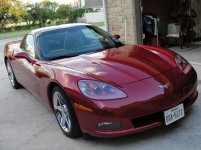Risumies, as you will be using the minidsp, you have the possibility to equalize a flat response for any driver you will be using. Or nice slightly rising response for 10+kHz..
But, even if the fr is same for two different drivers, they still might sound different. Directivity (dispersion) can be different, and different cone materials may have their own sound.
Also the woofer selection is easier with minidsp, you don't need to have driver with high Qts because you can compensate that with eq. For example the OB i built, would have been much more difficult to achieve good sound without dsp. So the minidsp is much, much more than plain active cross-over.
But, even if the fr is same for two different drivers, they still might sound different. Directivity (dispersion) can be different, and different cone materials may have their own sound.
Also the woofer selection is easier with minidsp, you don't need to have driver with high Qts because you can compensate that with eq. For example the OB i built, would have been much more difficult to achieve good sound without dsp. So the minidsp is much, much more than plain active cross-over.
Last edited:
Not necessarily so.... there are acoustical-mechanical realities that can NOT be worked around with a DSP! You can play all you want... it AIN'T going to happen!
You can only instill a higher QTS' into a low QTS driver up to a point. Iron law and all the rest. Suggest you rethink.... do a bit more research... build and play and see where you end up... you maybe surprised at the DSP limits!
You can only instill a higher QTS' into a low QTS driver up to a point. Iron law and all the rest. Suggest you rethink.... do a bit more research... build and play and see where you end up... you maybe surprised at the DSP limits!
When I was first building open baffle speaker (under John's guidance) I was using DSP because I had it - and it was fast and easy. The results weren't all that great. Moving to a simple passive crossover with the big inductor was a major change for the better.
DSP "should" be better, but I couldn't get it there. Real crossover parts did the trick like nothing else.
DSP "should" be better, but I couldn't get it there. Real crossover parts did the trick like nothing else.
Could you explain in bit more detail those realities?there are acoustical-mechanical realities that can NOT be worked around with a DSP
Because for sure you can reach exactly the same frequency response by DSP, analog line level EQ, or traditional passive cross-over. Max available SPL is depended only by driver cone area and excursion (at least when you have big enough amplifier)
BUT, where there is a clear difference, is the effect of amplifier damping factor to driver in DSP & line level EQ configuration. Passive XO has much higher output impedance compared to amplifier output. How that is affecting to perceived sound quality & musicality, please tell. I have not experimented that too much.
I agree Scott, and have said so on other threads. However, I just couldn't get my speakers to sound as good with DSP and John's do with passive parts. I gave up on the DSP for the Manzanita and just went with the simple passive crossover.
My DSP results were often close, they weren't a mile off, but just never quite as good.
My DSP results were often close, they weren't a mile off, but just never quite as good.
Yes, DSP can force a flat summation in the frequency domain... However... one thing I noticed years ago ... when multi-band equalizers became popular, and you forced a flat frequency response, it never sounded quite right. Surprised no one (to my knowledge) ever wrote a major paper about it.
I think there are a couple of things going on. To be clear, this is ALL supposition on my part based an building and listening to a LOT of speakers.
First, the big inductor... it is, by definition a filter. It is a TWO way filter. It, in my mind, functions much like a transformer. It not only provides HF roll off, but increase the Q of the system. It also effects the return EMF the amplifier sees. DSP doesn't do that. An electro-acoustical damper of sorts.
Then there is the upper harmonics issue. I do think passive crossovers can handle harmonic integrity better than a DSP. Can I prove that, nope. But I can hear it. Subtle dynamics seem more real... DSP tends to be dry.
Maybe a DPS set up does it's job TOO well. It would be interesting to hear Mr. Linkwitz's opinion on this. He is a big DSP advocate. Has forgotten more about passive crossovers than most of us will ever know.
I think there are a couple of things going on. To be clear, this is ALL supposition on my part based an building and listening to a LOT of speakers.
First, the big inductor... it is, by definition a filter. It is a TWO way filter. It, in my mind, functions much like a transformer. It not only provides HF roll off, but increase the Q of the system. It also effects the return EMF the amplifier sees. DSP doesn't do that. An electro-acoustical damper of sorts.
Then there is the upper harmonics issue. I do think passive crossovers can handle harmonic integrity better than a DSP. Can I prove that, nope. But I can hear it. Subtle dynamics seem more real... DSP tends to be dry.
Maybe a DPS set up does it's job TOO well. It would be interesting to hear Mr. Linkwitz's opinion on this. He is a big DSP advocate. Has forgotten more about passive crossovers than most of us will ever know.
Who, me? Maybe not..What kind of filters were you using?
Anyhow, when I first set up the DSP XO I was using LR4 filters, but they didn't sound good enough. Then I changed to LR2, which sounds a lot better. Other filters like Harsch, Bessel etc, I have not yet tried.
Filters
Hi
When you talk about filters and you say LR2 and LR4 etc., do you mean acuostical or electrical filter carateristic.
I have to admit that I do not know enough about filters. But I thought if the filters summarize perfectly acoustically around the crossover frequency everything should be fine. Especially if it summarizes at 15, 30 60 degrees etc too.
My DSP allows me to pick and combine 6 db, 12 db filters each with different frequencies and Qs so in combination with EQs I should be able to modulate any passive crossover, or am I wrong??
best regards
Uwe
Hi
When you talk about filters and you say LR2 and LR4 etc., do you mean acuostical or electrical filter carateristic.
I have to admit that I do not know enough about filters. But I thought if the filters summarize perfectly acoustically around the crossover frequency everything should be fine. Especially if it summarizes at 15, 30 60 degrees etc too.
My DSP allows me to pick and combine 6 db, 12 db filters each with different frequencies and Qs so in combination with EQs I should be able to modulate any passive crossover, or am I wrong??
best regards
Uwe
Finally posting some updated Manzanita info
As I indicated in a couple of recent posts, I have been working on some performance enhancements for the Manzanita. Most of the work concerns getting the most out of simple to fabricate wings. And I am still refining them.
After the usual playing around with heavy card board, I built a MDF prototype out of used, oh, I'm sorry, repurposed materials, including the drivers. OK, I'm cheap!
Anyway, here is what it looks like:
OK... Just kidding!
As I indicated in a couple of recent posts, I have been working on some performance enhancements for the Manzanita. Most of the work concerns getting the most out of simple to fabricate wings. And I am still refining them.
After the usual playing around with heavy card board, I built a MDF prototype out of used, oh, I'm sorry, repurposed materials, including the drivers. OK, I'm cheap!
Anyway, here is what it looks like:
OK... Just kidding!
Attachments
Ok... back to reality, 2nd attempt
Not so good at posting pictures... thought I had it. Must have pushed the wrong key.
Here goes again. BTW, for some reason the pics are not in proper rotation, as some are on their side. Told you I'm not any good at this. May have to get Pano to fix this for me.
Will comment on each in a separate post.
Not so good at posting pictures... thought I had it. Must have pushed the wrong key.
Here goes again. BTW, for some reason the pics are not in proper rotation, as some are on their side. Told you I'm not any good at this. May have to get Pano to fix this for me.
Will comment on each in a separate post.
Attachments
-
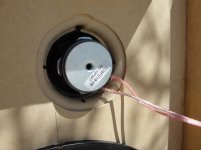 DSC01957.jpg938.1 KB · Views: 1,048
DSC01957.jpg938.1 KB · Views: 1,048 -
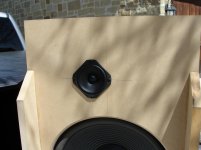 DSC01962.jpg861.7 KB · Views: 1,017
DSC01962.jpg861.7 KB · Views: 1,017 -
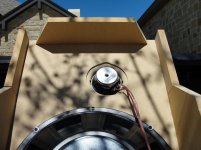 DSC01964.jpg798.6 KB · Views: 1,010
DSC01964.jpg798.6 KB · Views: 1,010 -
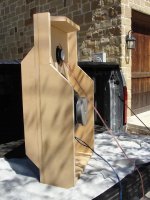 DSC01960.jpg153.5 KB · Views: 424
DSC01960.jpg153.5 KB · Views: 424 -
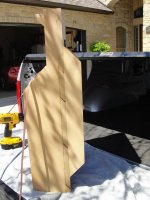 DSC01959.jpg114.7 KB · Views: 425
DSC01959.jpg114.7 KB · Views: 425 -
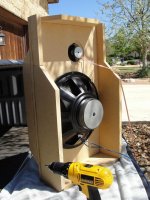 DSC01958.jpg133.5 KB · Views: 470
DSC01958.jpg133.5 KB · Views: 470 -
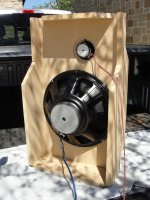 DSC01956.jpg147.4 KB · Views: 546
DSC01956.jpg147.4 KB · Views: 546 -
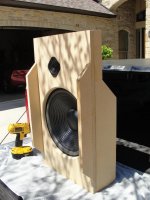 DSC01955.jpg115.8 KB · Views: 595
DSC01955.jpg115.8 KB · Views: 595 -
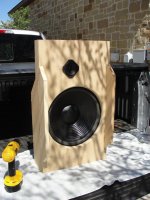 DSC01954.jpg152.9 KB · Views: 1,043
DSC01954.jpg152.9 KB · Views: 1,043 -
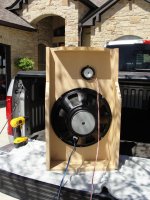 DSC01961.jpg174.3 KB · Views: 501
DSC01961.jpg174.3 KB · Views: 501
Why more complicated wings?
With the switch to the GRS 15, getting the more out of the wings was of interest to me. The GRS has a much higher QTS' than the Peerless and it's on baffle FS tends to be about 4-5 Hz lower. Both have similar Volume of Displacement (VD) with the Peerless having a slight edge. Free air efficiency of the GFS is about 3 db lower, but the much higher Q requires less equalization below about 60 Hz.
Mounting the GRS on the back side of the baffle adds a bit to the front to rear path length. Adding a 2.5" front wing depth adds a bit more and finally the revised system now has 5" of wing depth behind the baffle plate. All together the path distance has increased from around 12" or so to over 20".
This moves the effective F = from around 180 Hz to around 110 Hz.
The result is a lowering of system low end cut off from 45 - 48 Hz to 37 - 39Hz. And operating efficiency is up about 3 db.
The added front wing and longer - taller rear wing are glued to the main baffle board. This allows them to be fabricated with a simple sabre saw if needed. There is little or no shear load, so glue and clamping is strong enough. This assumes smooth and parallel mount surfaces. A table or circular saw is always a better bet. Still want to keep the system simple enough you could build it on an apartment patio if you had to.
With the switch to the GRS 15, getting the more out of the wings was of interest to me. The GRS has a much higher QTS' than the Peerless and it's on baffle FS tends to be about 4-5 Hz lower. Both have similar Volume of Displacement (VD) with the Peerless having a slight edge. Free air efficiency of the GFS is about 3 db lower, but the much higher Q requires less equalization below about 60 Hz.
Mounting the GRS on the back side of the baffle adds a bit to the front to rear path length. Adding a 2.5" front wing depth adds a bit more and finally the revised system now has 5" of wing depth behind the baffle plate. All together the path distance has increased from around 12" or so to over 20".
This moves the effective F = from around 180 Hz to around 110 Hz.
The result is a lowering of system low end cut off from 45 - 48 Hz to 37 - 39Hz. And operating efficiency is up about 3 db.
The added front wing and longer - taller rear wing are glued to the main baffle board. This allows them to be fabricated with a simple sabre saw if needed. There is little or no shear load, so glue and clamping is strong enough. This assumes smooth and parallel mount surfaces. A table or circular saw is always a better bet. Still want to keep the system simple enough you could build it on an apartment patio if you had to.
- Home
- Loudspeakers
- Multi-Way
- Fast, fun, Inexpensive OB project
